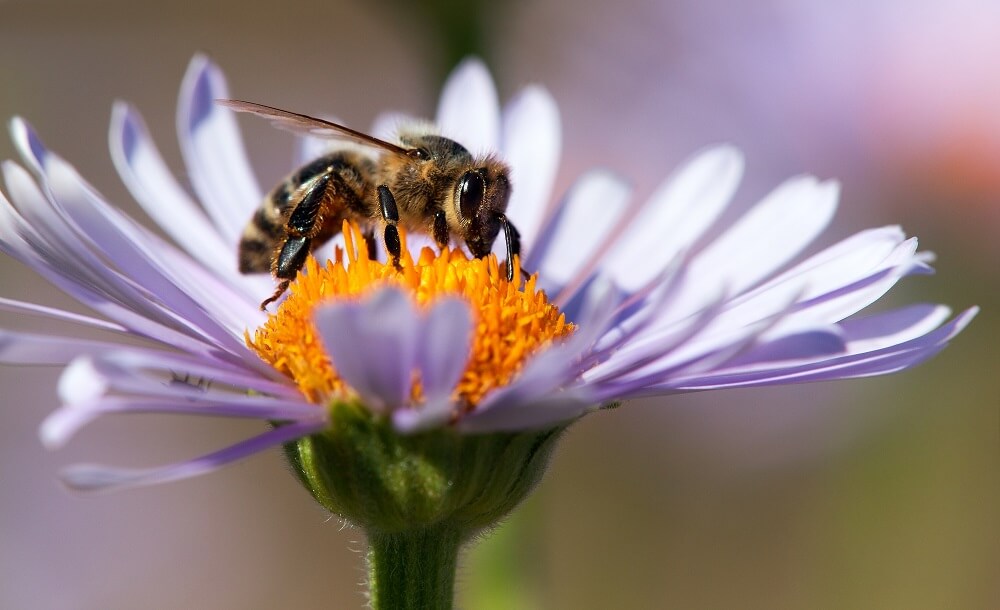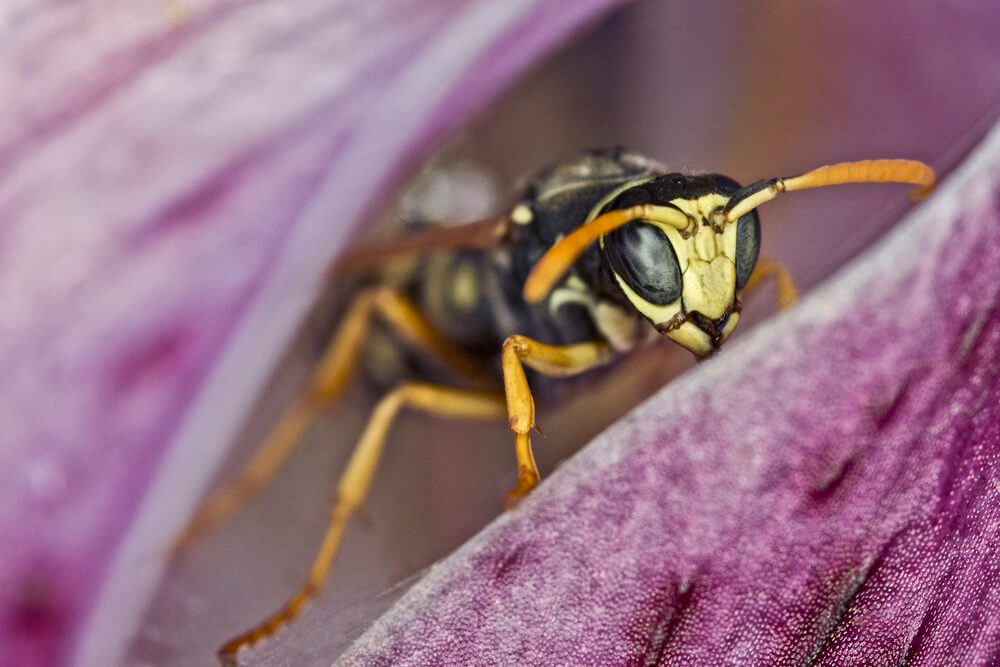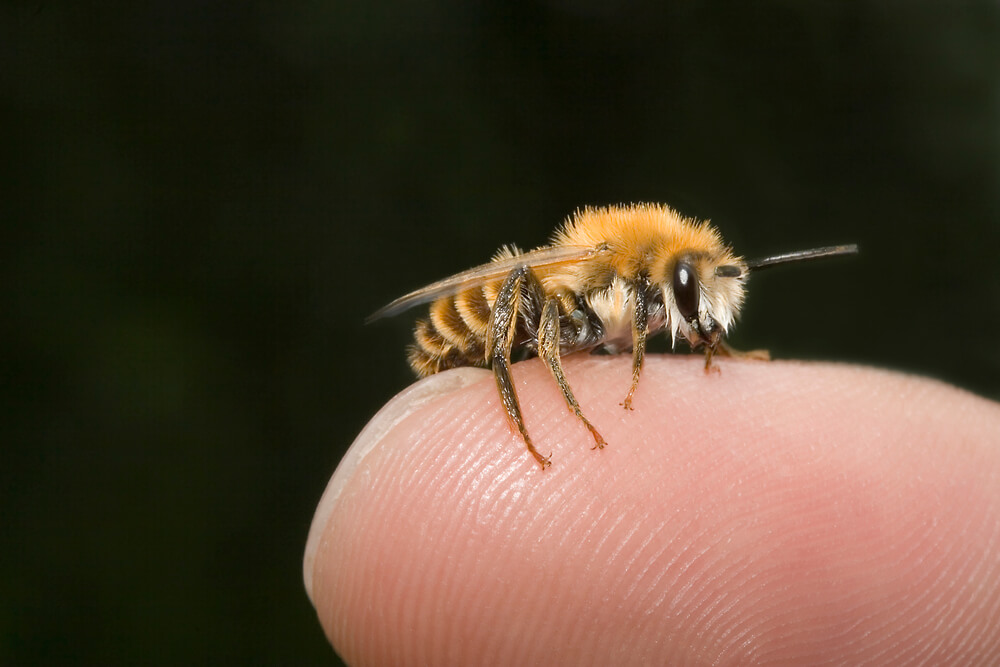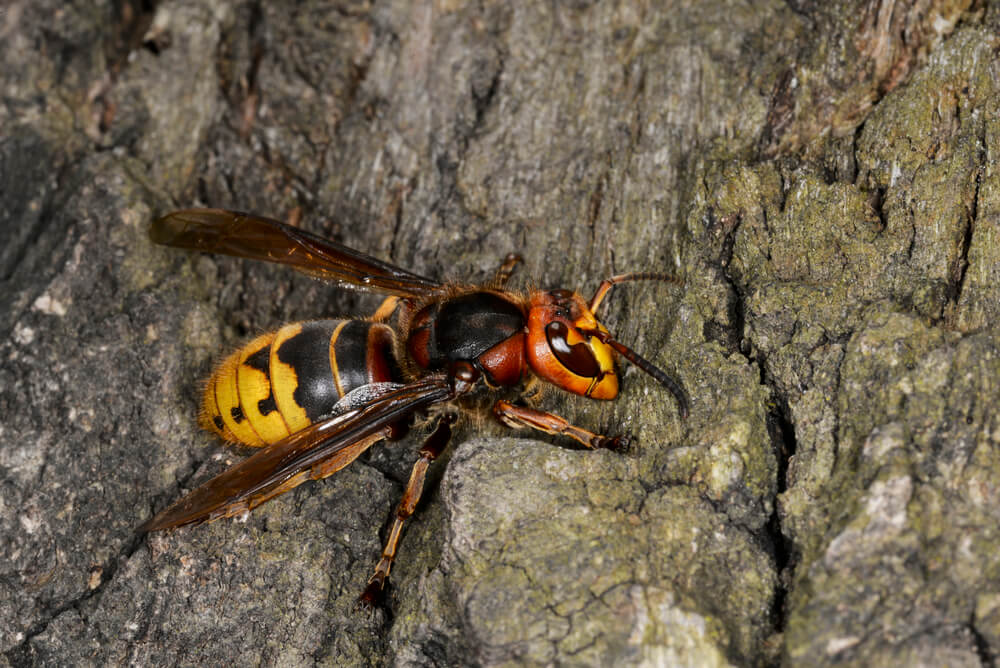In this article:
How Many Eyes Does a Bee Have?
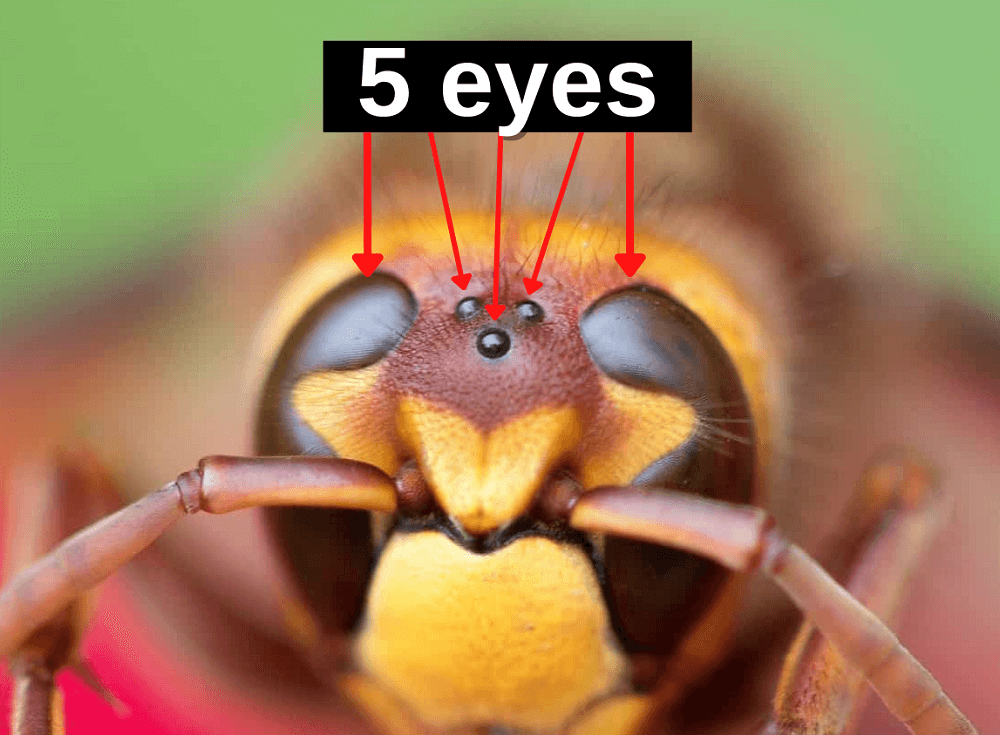
Bees have five eyes. They have two large eyes on the side of their head and three small eyes on the top.
Now you might be thinking:
But why do bees have five eyes?
Bees have five eyes because they serve different purposes.
For starters, the two large eyes on the side are called compound eyes. This set of eyes is used for seeing shapes and colors. The compound eyes also allow bees to find their way home.
And the coolest part?
Each of the compound eyes consists of thousands of individual lenses.
These lenses add together to provide a total picture of the bee’s surroundings. That’s why a bee’s vision is depicted as looking like several pieces of a puzzle put together.
Like this:
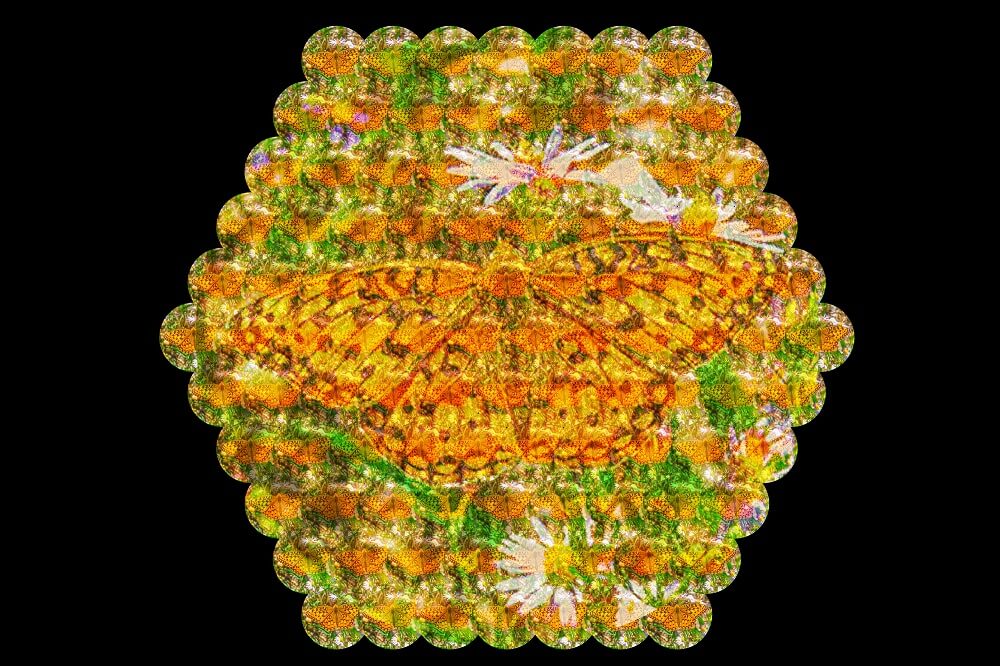
In contrast, humans have a single lens in their eyes.
Next, bees have three small eyes on the top of the head that are called ocelli. Ocelli comes from the Latin term “ocellus,” which means little eye.
Unlike compound eyes, the ocelli only have one single lens each. They’re used for navigation, orientation, and stability. Bees use their ocelli to view ultra-violet light which allows them to find flowers.
Now let’s get one big question cleared up:
Do All Bees Have 5 Eyes?
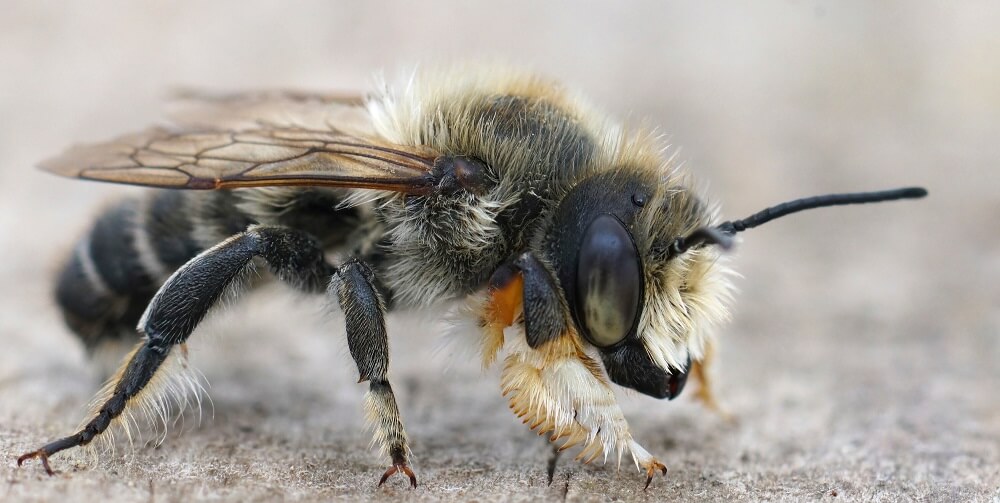
There are an estimated 20,000 species of bees. And yes, all of them have five eyes.
Remember, bees have two compound eyes and three ocelli eyes. The two compound eyes are on the side of their head, while the three ocelli eyes are on the top.
But here’s the thing:
The ocelli eyes are small, so they can be hard to see unless you’re looking at a zoomed-in picture of a bee. Also, many bees have fuzzy heads, so the ocelli eyes can appear hidden.
Here’s a video of a honeybee cleaning one of her compound eyes:
Notice how the three eyes on top of her head are hard to spot?
But make no mistake.
Even though you can’t really see her ocelli eyes, they’re still there.
How Far Can a Bee See?

A bee’s visual range is generally less than 100 feet. On the other hand, humans can see up to 3 miles away.(1)
But there’s more:
Like humans, bees are trichromatic. This means they have three photoreceptors in their eyes and base their color combinations on three colors.
But this is where humans and bees differ.
Humans’ eyesight is based on the three primary colors:
- Red
- Green
- Blue
By mixing these primary colors, we can create secondary colors. For example, mixing red and blue makes purple.
Bees’ eyesight is based on:
- Ultraviolet light
- Green
- Blue
Unlike humans, bees can’t see the color red because they don’t have the photoreceptors for it. They can, however, detect reddish wavelengths such as yellow and orange.
Bees can also see UV light which is invisible to humans.
Compare the difference between human vision and bee vision:
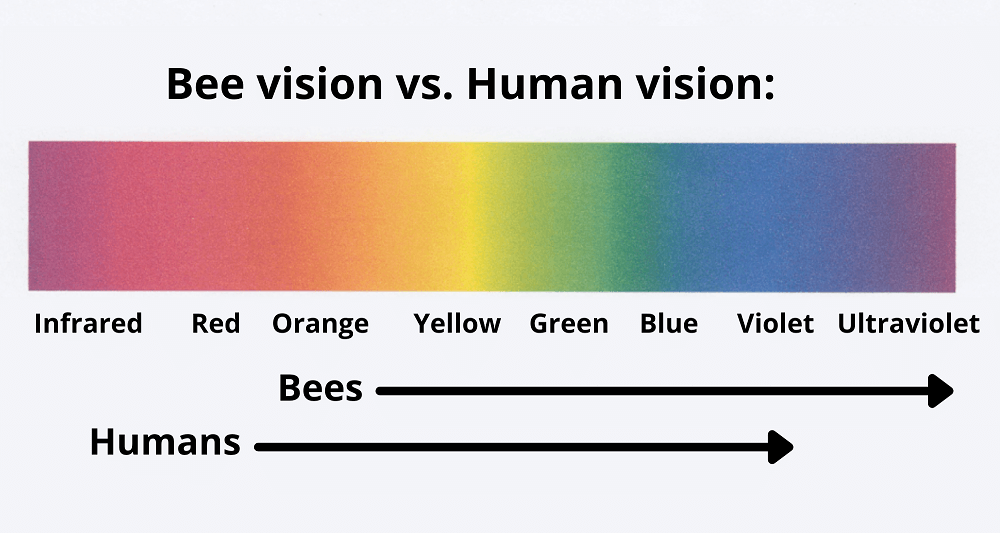
Humans typically see in the UV spectrum’s 700-400 nanometer range. Bees can see from the 600-300 nanometer range.
So, in a nutshell?
Bees can see green, blue, and violet really well. This is why bees are attracted to, say, blue flowers, for example.
In contrast, birds are more drawn to red and orange flowers since these colors appear more vivid to them.
But don’t get me wrong:
Bees still pollinate red flowers.
Even though bees can’t see the color red, they can still see the ultra-violet markings inside the red bloom that humans can’t see. These UV markings grab their attention and attract them.
In very rare situations, people can see into the ultra-violet range. It’s usually after a lens injury or cataract surgery. This condition is called aphakia. People with aphakia see a “near” UV light.
FAQs on “How Many Eyes Does a Bee Have?”
- Do bees see at night?
- Do bees close their eyes?
- Do bees have hairy eyeballs?
- Do bees have 100 eyes?
- How many simple eyes does a bee have?
- How many compound eyes does a bee have?
- Can bees see color?
- Are bees blind?
- Do bees hate red?
- How do bees see humans?
- What are bees eyes called?
- How do bees clean their eyes?
- How many eyes does a bumblebee have?
Do bees see at night?

Yes, some bees see at night, but not all of them. It depends on the species.
That said, most bee species won’t fly when it’s dark. Instead, they’ll say in their hive or nest, conserving their energy.
Bees’ methods for dealing with the dark vary from species to species. It’s also affected by the amount of light available.
Bees can be split into three categories, which are:
- Diurnal – They’re active during daylight. When it starts getting dark, they’ll return to their hive or nest for safety.
- Crepuscular – These bees are active during dawn and dusk (aka twilight). They’ll come out only during these periods. As a result, they’ll spend most of their time inside their nest or hive.
- Nocturnal -This is the type of bee that emerges only at night.
Diurnal bees will make up the vast majority of species. There are, however, a few crepuscular and nocturnal species. These are generally found in tropical regions of the world.
For example, the Indian Carpenter bee is nocturnal.
Examining the bee’s eyes is one of the simplest methods to determine whether it is nocturnal, crepuscular, or diurnal. Nocturnal bees require more light to navigate effectively, therefore their eyes will be significantly larger than those of diurnals.
There are several reasons why some bees are nocturnal or crepuscular while most aren’t. This can include:
- Flowering at night – Certain flowers will only open at night. If bees aren’t flying at night, they won’t be able to gather nectar from these flowers. Flowers like this are more common in tropical environments.
- Less competition – There are more pollinators to deal with during the day. This might be a nuisance, requiring them to compete for nectar and pollen. At night, this pressure will be reduced dramatically.
- Protection from predators – Most predators assume that bees are active during the day. If they go out at night, they won’t attract the attention of these predators.
- Lack of water – When flying during the day, this will cause them to lose water more rapidly. This may be an issue in areas where it’s dry.
—> Go back to the FAQs on “How many eyes does a bee have?”
More to Explore:
Do bees close their eyes?
No, bees and other insects don’t have eyelids like humans do, so they can’t close their eyes.
The insect eye evolved differently than the mammalian eye and never developed eyelids. Instead, bees manually clean their eyes using their forelegs.
Here’s a honeybee cleaning her eyes:
In humans and mammals, blinking helps clean our eyes.
Also, bees’ eyes don’t need moisture like human eyes do.
—> Go back to the FAQs on “How many eyes does a bee have?”
More to Explore:
Do bees have hairy eyeballs?
Yes, some bee species have hairy eyeballs. But not all of them. Honeybees are a common example of bees that have hair on their eyes.
—> Go back to the FAQs on “How many eyes does a bee have?”
More to Explore:
Do bees have 100 eyes?
This is a common question regarding bees. We also get asked things like:
Why do bees have 5 eyes? Why does a bee have 5 eyes? What do bee eyes do? Do bees have 2 eyes?
The truth is that bees have five eyes. There are three small ones on the top of their head and two large ones on the side. Like humans, bees need their eyes to see.
Compound eyes are the two large eyes on the side. This set of eyes is for seeing shapes and colors. Compound eyes also aid bees in locating their way home.
Each of the bee’s compound eyes is made up of thousands of tiny lenses. The sum of these lenses comes together like a puzzle.
Like this:

The human eye, on the other hand, has only one lens.
The three little eyes on the top of the head are known as ocelli. “Ocellus” is a Latin term meaning “little eye.”
The ocelli are tiny, round eyes with only one lens. They’re utilized for navigation, orientation, and stability. Bees also use their ocelli to detect ultra-violet light to find flowers.
—> Go back to the FAQs on “How many eyes does a bee have?”
More to Explore:
How many simple eyes does a bee have?
Bees have three “simple” eyes on the top of their head. These eyes are called ocelli, and they form a triangle.
—> Go back to the FAQs on “How many eyes does a bee have?”
More to Explore:
How many compound eyes does a bee have?
There are two compound eyes located on the sides of a bee’s head. They’re large and easy to spot.
—> Go back to the FAQs on “How many eyes does a bee have?”
More to Explore:
Can bees see color?
Yes, bees can see certain colors like blue, green, and violet. They can also see in the ultraviolet spectrum which humans can’t. But bees can’t see the color red. They can only see reddish colors like orange or yellow.
Humans and bees have different photoreceptors. Humans see colors based on red, green, and blue. But as mentioned, bees see colors based on blue, green, and ultraviolet light.
—> Go back to the FAQs on “How many eyes does a bee have?”
More to Explore:
Are bees blind?
No, not at all. Bees have five eyes to see with.
—> Go back to the FAQs on “How many eyes does a bee have?”
More to Explore:
- How Many Wings Does a Bee Have?
- Ground Bees: Are They a Threat to Your Yard?
- Why Do Vulture Bees Eat Rotting Flesh?
Do bees hate red?

Bees can’t see the color red. This means the color red appears black to bees because black is the absence of color.
That said, bees can perceive dark colors as a threat because many of their natural predators are dark. Think bears, skunks, and honey badgers. So since red appears black, it can be seen as threatening to bees.
This is why beekeepers wear white. It’s a light color that doesn’t trigger bees. Also, because white reflects less heat than darker colors, it’s more comfortable for the beekeeper than a darker suit.
—> Go back to the FAQs on “How many eyes does a bee have?”
More to Explore:
How do bees see humans?
As it turns out, bees see humans very well.
According to one study, honeybees can recognize and remember individual human faces for up to 2 days.(2)
Scientist Adrian Dyer ran an experiment to determine how well bees recognize faces.
How’d he do it?
He started by pinning photos of four different people onto a board. Then he selected a target face that he wanted the bees to remember. He moved the pictures around and rewarded the bees with a sucrose solution every time they selected the target face.
The bees continued to approach the target face correctly up to 90% of the time even after the reward was eliminated.
The memories stuck in the bees’ brains: Even two days after being trained, the bees could still find the target face.
—> Go back to the FAQs on “How many eyes does a bee have?”
More to Explore:
What are bees eyes called?
The two large eyes on the sides of their heads are called compound eyes. The three small eyes on the top are called ocelli. Together, this means bees have five eyes in total.
—> Go back to the FAQs on “How many eyes does a bee have?”
More to Explore:
How do bees clean their eyes?
Bees will use their legs to clean their eyes. Here’s an example of a honeybee cleaning her eyes:
—> Go back to the FAQs on “How many eyes does a bee have?”
More to Explore:
How many eyes does a bumblebee have?
People are often curious about the number of eyes that different bee species have. So they regularly ask:
How many eyes does a carpenter bee have? How many eyes does a sweat bee have? How many eyes does a honeybee have?
The answer is that all bees have five eyes. They have two large eyes called compound eyes which are located on the side of their heads. They also have three tiny eyes called ocelli which are found on the top of their head.
